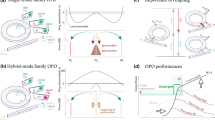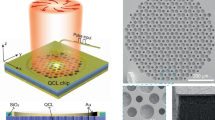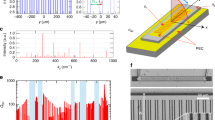Abstract
Optical parametric oscillation is a nonlinear process that enables coherent generation of ‘signal’ and ‘idler’ waves, shifted in frequency from the pump wave1,2. Efficient parametric conversion is the paradigm for the generation of twin or entangled photons for quantum optics applications such as quantum cryptography3,4, or for the generation of new frequencies in spectral domains not accessible by existing devices. Rapid development in the field of quantum information requires monolithic, alignment-free sources that enable efficient coupling into optical fibres and possibly electrical injection. During the past decade, much effort has been devoted to the development of integrated devices for quantum information5,6,7 and to the realization of all-semiconductor parametric oscillators8,9. Nevertheless, at present optical parametric oscillators typically rely on nonlinear crystals placed into complex external cavities, and pumped by powerful external lasers. Long interaction lengths are typically required and the phase mismatch between the parametric waves propagating at different velocities2 results in poor parametric conversion efficiencies. Here we report the demonstration of parametric oscillation in a monolithic semiconductor triple microcavity with signal, pump and idler waves propagating along the vertical direction of the nanostructure. Alternatively, signal and idler beams can also be collected at finite angles, allowing the generation of entangled photon pairs. The pump threshold intensity is low enough to envisage the realization of an all-semiconductor electrically pumped micro-parametric oscillator.
This is a preview of subscription content, access via your institution
Access options
Subscribe to this journal
Receive 51 print issues and online access
$199.00 per year
only $3.90 per issue
Buy this article
- Purchase on Springer Link
- Instant access to full article PDF
Prices may be subject to local taxes which are calculated during checkout




Similar content being viewed by others
References
Shen, Y. R. The Principles of Nonlinear Optics (Wiley Inter-Science, Hoboken, 2003)
Armstrong, J. A., Bloembergen, N., Ducuing, J. & Pershan, P. S. Interaction between light waves in a nonlinear dielectric. Phys. Rev. 127, 1918–1939 (1962)
Jennewein, T., Simon, C., Weihs, G., Weinfurter, H. & Zeilinger, A. Quantum cryptography with entangled photons. Phys. Rev. Lett. 84, 4729–4732 (2000)
Gisin, N., Robordy, G., Tittel, W. & Zbinden, H. Quantum cryptography. Rev. Mod. Phys. 74, 145–195 (2002)
Santori, C., Fattal, D., Vuckovic, J., Solomon, G. S. & Yamamoto, Y. Indistinguishable photons from a single-photon device. Nature 419, 594–597 (2002)
Moreau, E. et al. Single-mode solid-state single photon source based on isolated quantum dots in pillar microcavities. Appl. Phys. Lett. 79, 2865–2867 (2001)
Tanzilli, S. et al. Highly efficient photon-pair source using a periodically poled lithium niobate waveguide. Electron. Lett. 37, 26–28 (2001)
Haïdar, R., Forget, N. & Rosencher, E. Optical parametric oscillation in microcavities based on isotropic semiconductors: a theoretical study. IEEE J. Quant. Elec. 39, 569–576 (2003)
Vodopyanov, K. L. et al. Optical parametric oscillation in quasi-phase-matched GaAs. Opt. Lett. 29, 1912–1914 (2004)
Fiore, A., Berger, V., Rosencher, E., Bravetti, P. & Nagle, J. Phase matching using an isotropic nonlinear optical material. Nature 391, 463–466 (1998)
Baudrier-Raybaut, M., Haïdar, R., Kupecek, Ph., Lemasson, Ph. & Rosencher, E. Random quasi-phase-matching in bulk polycrystalline isotropic nonlinear materials. Nature 432, 374–376 (2004)
Myers, L. E., Miller, G. D., Eckardt, R. C., Fejer, M. M. & Byer, R. L. Quasi-phase-matched 1.064-µm-pumped optical parametric oscillator in bulk periodically poled LiNbO3 . Opt. Lett. 20, 52–54 (1995)
Mertz, J., Debuisschert, T., Heidmann, A., Fabre, C. & Giacobino, E. Improvements in the observed intensity correlation of optical parametric oscillator twin beams. Opt. Lett. 16, 1234–1236 (1991)
Teja, J. & Wong, N. C. Twin-beam generation in a triply resonant dual-cavity optical parametric oscillator. Opt. Exp. 2, 65–71 (1998)
Savvidis, P. G. et al. Angle-resonant polariton amplifier. Phys. Rev. Lett. 84, 1547–1550 (2000)
Saba, M. et al. High-temperature ultrafast polariton parametric amplification in semiconductor microcavities. Nature 414, 731–735 (2001)
Dasbach, G. et al. Polarization inversion via parametric parametric scattering in quasi-one-dimensional microcavities. Phys. Rev. B 71, 161308(R) (2005)
Weisbuch, C., Nishioka, M., Ishikawa, A. & Arakawa, Y. Observation of the coupled exciton-photon mode splitting in a semiconductor quantum microcavity. Phys. Rev. Lett. 69, 3314–3317 (1992)
Ciuti, C., Schwendimann, P., Deveaud, B. & Quattropani, A. Theory of the angle-resonant polariton amplifier. Phys. Rev. B 62, R4825–R4828 (2000)
Diederichs, C. & Tignon, J. Design for a triply resonant vertical emitting micro-optical parametric oscillator. Appl. Phys. Lett. 87, 251107 (2005)
Stanley, R. P., Houdré, R., Oesterle, U., Ilegems, M. & Weisbuch, C. Coupled semiconductor microcavities. Appl. Phys. Lett. 65, 2093–2095 (1994)
Pellandini, P. et al. Dual-wavelength laser emission from a coupled semiconductor microcavity. Appl. Phys. Lett. 71, 864–866 (1997)
Michler, P., Hilpert, M. & Reiner, G. Dynamics of dual-wavelength emission from a coupled semiconductor microcavity laser. Appl. Phys. Lett. 70, 2073–2075 (1997)
Armitage, A. et al. Optically induced splitting of bright excitonic states in coupled quantum microcavities. Phys. Rev. B 57, 14877–14881 (1998)
Savvidis, P. G. et al. Off-branch polaritons and multiple scattering in semiconductor microcavities. Phys. Rev. B 64, 075311 (2001)
Ciuti, C. Branch-entangled polariton pairs in planar microcavities and photonic wires. Phys. Rev. B 69, 245304 (2004)
Ou, Z. Y. & Mandel, L. Further evidence of nonclassical behavior in optical interference. Phys. Rev. Lett. 62, 2941–2944 (1989)
Ou, Z. Y. Quantum theory of fourth-order interference. Phys. Rev. A. 37, 1607–1619 (1988)
Tignon, J., Ciuti, C., Dasbach, G., & Diederichs, C. Micro-optical parametric oscillator with coupled cavities. French patent application number 05/05 708 (filed 06 June 2005).
Acknowledgements
This work was financially supported by the ‘Clermont 2’ project and the Délégation Générale pour l'Armement (DGA). LPA de l'ENS is ‘Unité Mixte de Recherche Associée au CNRS et aux Universités Paris 6 et 7’.
Author information
Authors and Affiliations
Corresponding author
Ethics declarations
Competing interests
J. Tignon, C. Ciuti, G. Dasbach and C. Diederichs have filed a patent based on this work (French patent application number 05/05 708; filing date 06 June 2005).
Supplementary information
Supplementary Figure
Scheme for the electrical injection. This file contains additional information on the electrical injection of the triple microcavity: a sketch of the electrically injected system, the dielectric structure and the calculated reflectivity. (DOC 52 kb)
Rights and permissions
About this article
Cite this article
Diederichs, C., Tignon, J., Dasbach, G. et al. Parametric oscillation in vertical triple microcavities. Nature 440, 904–907 (2006). https://doi.org/10.1038/nature04602
Received:
Accepted:
Issue Date:
DOI: https://doi.org/10.1038/nature04602
This article is cited by
-
Triple threshold lasing from a photonic trap in a Te/Se-based optical microcavity
Communications Physics (2019)
-
Phase-matching-free parametric oscillators based on two-dimensional semiconductors
Light: Science & Applications (2018)
-
Functionalized organic frameworks explored as second order NLO agents
Journal of Chemical Sciences (2016)
-
Formation and control of Turing patterns in a coherent quantum fluid
Scientific Reports (2013)
-
Strong light–matter interaction in ZnO microcavities
Light: Science & Applications (2013)
Comments
By submitting a comment you agree to abide by our Terms and Community Guidelines. If you find something abusive or that does not comply with our terms or guidelines please flag it as inappropriate.



